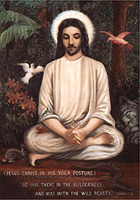USA
December 22, 2003 VNN8488

Hindus For Jesus

FROM BELIEFNET

 USA, Dec 22 (VNN) — Who'll be singing carols and reading the Nativity story on Christmas Eve this year? Many American Hindus. USA, Dec 22 (VNN) — Who'll be singing carols and reading the Nativity story on Christmas Eve this year? Many American Hindus.
By Stephen Prothero
Today in Hindu homes and temples across the United States a striking image of divinity is on display. Dressed in a flowing white robe, his long hair pulled back behind slight shoulders, this holy man sits, half-lotus style, eyes cast down, in meditation. A halo rings his head, and his body is framed, St. Francis-like, by wild animals. "He was there in the wilderness," the accompanying text reads, "and was with the wild beasts" (Mark 1:13). Painted in the 1920s by Eugene Theodosia Oliver, a Catholic, in keeping with instructions from a Hindu monk, the image is called Christ the Yogi. This Jesus is clearly at peace with nature, with himself, and with God. He knows precisely who he is. And who he is, quite plainly, is a Hindu.
The story behind the diffusion of this image-an image nearly as recognizable in U.S. Hindu circles as Warner Sallman's 'Head of Christ' is among U.S. Protestants-is the story of the Vedanta Society. It is also a tale of how Jesus became an American icon, and how American Hindus contributed to that transformation.
But first let's consider Jesus. His undeniable popularity here can be traced, of course, to the fact that the overwhelming majority of Americans are Christians. But if Christians had maintained a monopoly over interpreting Jesus, he would not have become a national celebrity. That distinction can be traced to the audacious efforts of America's freethinkers and Jews, Buddhists and Hindus who have, in a sense, stolen Jesus away from the organized churches, freeing him to be (in Paul's words) "all things to all people." Buddhists who follow the Dalai Lama see Jesus as a bodhisattva. Hare Krishnas worship Jesus as an incarnation of their Supreme Lord Krishna. Daoists call him the "Eternal Dao."
Meanwhile, congregants at the San Francisco Vedanta Society, where the original Christ the Yogi hangs, revere Jesus as a "great Yogin" with highly developed "psychic powers." These congregants trace their lineage back to Ramakrishna, an Indian mystic from West Bengal, who was graced with a vision of Jesus while meditating on the Madonna and Child in 1874. Soon his disciples were also cultivating the "Jesus state." Shortly after Ramakrishna's death in 1886, twelve of his followers gathered on Christmas Eve to discuss Jesus, his life of renunciation, and his realization of God-consciousness. Their leader, Swami Vivekananda, spoke of Jesus' life, death, and resurrection. He described how the apostle Paul had "preached the gospel of the Arisen Christ and spread Christianity far and wide." He said it was time for them to go and do likewise.
Read full story
Contact VNN about this story Send this story to a friend Send this story to a friend This story URL: http://vaishnava-news-network.org/usa/US0312/US22-8488.html
NEWS DESK | USA | TOP
Surf the Web on

|







